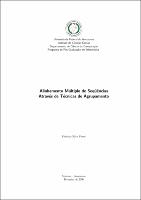| ???jsp.display-item.social.title??? |


|
Please use this identifier to cite or link to this item:
https://tede.ufam.edu.br/handle/tede/2927| ???metadata.dc.type???: | Dissertação |
| Title: | Alinhamento múltiplo de seqüências através de técnicas de agrupamento |
| Other Titles: | Multiple alignment of sequences through clustering techniques |
| ???metadata.dc.creator???: | Peres, Patrícia Silva  |
| ???metadata.dc.contributor.advisor1???: | Moura, Edleno Silva de |
| ???metadata.dc.description.resumo???: | O alinhamento simultâneo entre várias seqüências de DNA ou proteína é um dos principais problemas em biologia molecular computacional. Alinhamentos múltiplos são importantes em muitas aplicações, tais como, predição da estrutura de novas seqüências, demonstração do relacionamento entre novas seqüências e famílias de seqüências já existentes, inferência da história evolutiva de uma família de seqüências, descobrimento de padrões que sejam compartilhados entre seqüências, montagem de fragmentos de DNA, entre outras. Atualmente, a estratégia mais popular utilizada na resolução do problema do alinhamento múltiplo é o alinhamento progressivo. Cada etapa desta estratégia pode gerar uma taxa de erro que tenderá a ser baixa no caso de seqüências muito similares entre si, porêm tenderá a ser alta na medida em que as seqüências divergirem. Portanto, a determinação da ordem de alinhamento das seqüências constitui-se em um passo fundamental na estratégia de alinhamento progressivo. Estratégias tradicionais levam em consideração, a cada iteração do alinhamento progressivo, apenas o par ou grupo de seqüências mais próximo a ser alinhado. Tal estratégia minimiza a taxa de erro introduzida em cada etapa, porém pode não ser a melhor forma para minimizar a taxa de erro final. Baseado nesta hipótese, este trabalho tem por objetivo o estudo e aplicação de uma técnica de agrupamento global para executar uma análise prévia de todas as seqüências de forma a separálas em grupos de acordo com suas similaridades. Estes grupos, então, guiarão o alinhamento progressivo tradicional, numa tentativa de minimizar a taxa de erro global introduzida pelas etapas do alinhamento progressivo e melhorar o resultado final. Para avaliar a contabilidade desta nova estratégia, três métodos conhecidos foram modificados com o objetivo de agregar a nova etapa de agrupamento de seqüências. A acurácia das novas versões dos métodos foi testada utilizando três diferentes coleções de referências. Além disso, os métodos modificados foram comparadas com suas respectivas versões originais. Os resultados dos experimentos mostram que as novas versões dos métodos com a etapa de agrupamento global realmente obtiveram alinhamentos melhores do que suas versões originais nas três coleções de referência e alcançando melhorias sobre os principais métodos encontrados na literatura, com um aumento de apenas 3% em média no tempo de execução. |
| Abstract: | The simultaneous alignment of many DNA or protein sequences is one of the commonest tasks in computational molecular biology. Multiple alignments are important in many applications, such as, predicting the structure of new sequences, demonstrating the relationship between new sequences and existing families of sequences, inferring the evolutionary history of a family of sequences,finding the characteristic motifs (core blocks) between biological sequences, assembling fragments in DNA sequencing, and many others. Currently, the most popular strategy used for solving the multiple sequence alignment problem is the progressive alignment. Each step of this strategy might generate an error which is expected to be low for closely related sequences but increases as sequences diverge. Therefore, determining the order in which the sequences will be aligned is a key step in the progressive alignment strategy. Traditional approaches take into account, in each iteration of the progressive alignment, only the closest pair or groups of sequences to be aligned. Such strategy minimizes the error introduced in each step, but may not be the best option to minimize the final error. Based on that hypothesis, this work aims the study and the application of a global clustering technique to perform a previous analysis of all sequences in order to separate them into groups according to their similarities. These groups, then, guide the traditional progressive alignment, as an attempt to minimize the overall error introduced by the steps of the progressive alignment and improve the final result. To assess the reliability of this new strategy, three well-known methods were modified for the purpose of introducing the new sequence clustering stage. The accuracy of new versions of the methods was tested using three diferent reference collections. Besides, the modified methods were compared with their original versions. Results of the conducted experiments depict that the new versions of the methods with the global clustering stage really obtained better alignments than their original versions in the three reference collections and achieving improvement over the main methods found in literature, with an increase of only 3% on average in the running time. |
| Keywords: | Alinhamento Múltiplo de Seqüências Estratégia de Alinhamento Progressivo Técnicas de Agrupamento Multiple alignment of sequences Progressive alignment strategy Clustering techniques |
| ???metadata.dc.subject.cnpq???: | CIÊNCIAS EXATAS E DA TERRA: CIÊNCIA DA COMPUTAÇÃO |
| Language: | por |
| ???metadata.dc.publisher.country???: | BR |
| Publisher: | Universidade Federal do Amazonas |
| ???metadata.dc.publisher.initials???: | UFAM |
| ???metadata.dc.publisher.department???: | Instituto de Computação |
| ???metadata.dc.publisher.program???: | Programa de Pós-graduação em Informática |
| Citation: | PERES, Patrícia Silva. Alinhamento múltiplo de seqüências através de técnicas de agrupamento. 2006. 61 f. Dissertação (Mestrado em Informática) - Universidade Federal do Amazonas, Manaus, 2006. |
| ???metadata.dc.rights???: | Acesso Aberto |
| URI: | http://tede.ufam.edu.br/handle/tede/2927 |
| Issue Date: | 24-Feb-2006 |
| Appears in Collections: | Mestrado em Informática |
Files in This Item:
| File | Description | Size | Format | |
|---|---|---|---|---|
| Patricia Silva Peres.pdf | 494.6 kB | Adobe PDF |  Download/Open Preview |
Items in DSpace are protected by copyright, with all rights reserved, unless otherwise indicated.




